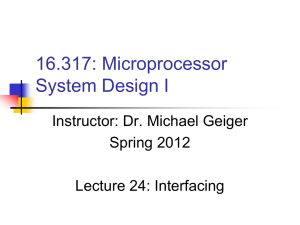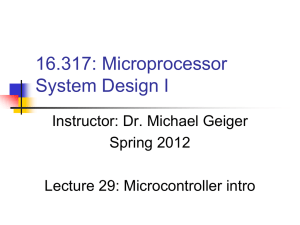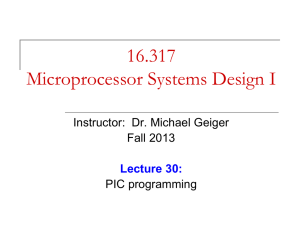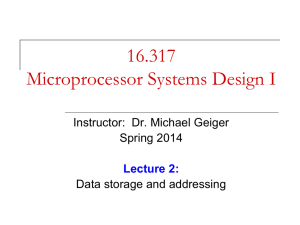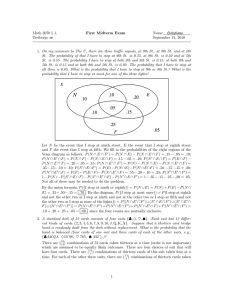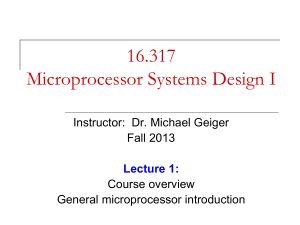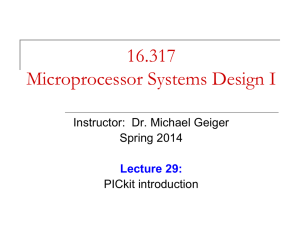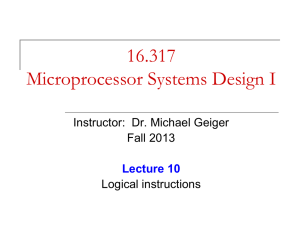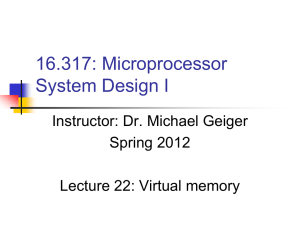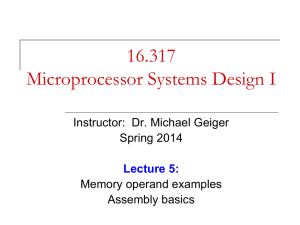compare, conditional execution
advertisement
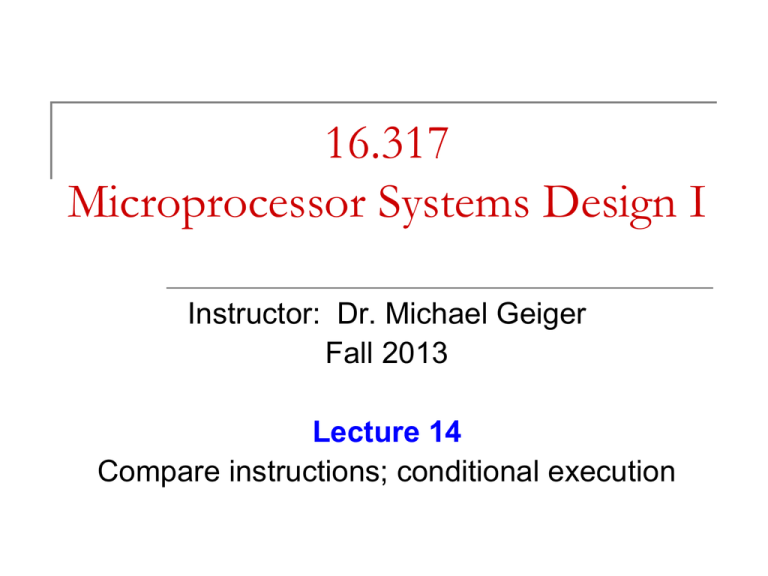
16.317 Microprocessor Systems Design I Instructor: Dr. Michael Geiger Fall 2013 Lecture 14 Compare instructions; conditional execution Lecture outline Announcements/reminders HW 4 to be posted; due 10/16 Exam 1 regrade requests due 10/11 Today’s lecture Compare instructions CMOV Set on condition Early feedback forms 4/8/2015 Microprocessors I: Lecture 14 2 Compare Instructions Compare 2 values; store result in ZF/SF General format: CMP D,S Works by performing subtraction (D) – (S) ZF/SF/OF indicate result (signed values) 4/8/2015 D, S unchanged ZF = 1 ZF = 0, (SF XOR OF) = 1 ZF = 0, (SF XOR OF) = 0 D == S D<S D>S Microprocessors I: Lecture 14 3 Compare Instructions- Example • Example—Initialization of internal registers with immediate data and compare. Example: MOV AX,1234H ;Initialize AX MOV BX,ABCDH ;Initialize BX CMP AX,BX ;Compare AX-BX • Data registers AX and BX initialized from immediate data IMM16 (AX) = 1234H + integer IMM16 (BX) = ABCDH - integer • Compare computation performed as: (AX) = 00010010001101002 (BX) = 10101011110011012 (AX) – (BX) = 00010010001101002 - 10101011110011012 ZF = 0 = NZ SF = 0 = PL ;treats as signed numbers CF = 1 = CY AF = 1 = AC OF = 0 = NV PF = 0 = PO 4/8/2015 Microprocessors I: Lecture 14 4 Condition codes Conditional execution: result depends on value of flag bit(s) Intel instructions specify condition codes Condition code implies certain flag values Opcodes written with cc as part of name cc can be replaced by any valid code Examples: CMOVcc, SETcc, Jcc 4/8/2015 Specific examples: CMOVE, SETL, SETZ, JNE, JG Microprocessors I: Lecture 14 5 Condition codes (cont.) Testing overflow Testing carry flag C (CF = 1) NC (CF = 0) Testing sign flag O (OF = 1), NO (OF =0) S (SF = 1), NS (SF = 0) Testing parity flag 4/8/2015 P or PE (PF = 1) NP or PO (PF = 0) Microprocessors I: Lecture 14 6 Condition codes (cont.) Testing equality/zero result Signed comparison E or Z (ZF = 1) NE or NZ (ZF = 0) L or NGE (SF XOR OF = 1) NL or GE (SF XOR OF = 0) LE or NG ((SF XOR OF) OR ZF = 1) NLE or G ((SF XOR OF) OR ZF = 0) Unsigned comparison 4/8/2015 “Below” less than, “above” greater than B, NAE (CF = 1) NB, AE (CF = 0) BE or NA (CF OR ZF = 1) NBE or A (CF OR ZF = 0) Microprocessors I: Lecture 14 7 Conditional move (CMOV) Only in Pentium Pro & later Perform move only if condition is true Examples: 4/8/2015 CMOVZ CMOVG AX, [SI] move if ZF == 1 EBX, EAX move if greater than Microprocessors I: Lecture 14 8 Byte Set on Condition Instruction Byte set on condition instruction Used to set byte based on condition code Can be used for boolean results—complex conditions General format: 4/8/2015 SETcc D cc = one of the supported conditional relationships Microprocessors I: Lecture 14 9 Byte Set on Condition Instruction • • • Operation: Flags tested for conditions defined by “cc” and the destination in a register or memory updated as follows If cc test True: 000000012 = 01H D If cc test False: 000000002 = 00H D Examples of conditional tests: SETE = set byte if equal ZF = 1 SETC = set byte if carry CF =1 SETBE = set byte if below or equal CF = 1 +(or) ZF = 1 Example: SETA AL = set byte if above if CF = 0 (and) ZF = 0 (AL) = 01H Otherwise, (AL) =00H 4/8/2015 Microprocessors I: Lecture 14 10 Example Show the results of the following instructions, assuming that “A” = DS:100H = 0001H “B” = DS:102H = 0003H “C” = DS:104H = 1011H “D” = DS:106H = 1011H “E” = DS:108H = ABCDH “F” = DS:10AH = DCBAH What complex condition does this sequence test? 4/8/2015 MOV CMP SETLE MOV CMP SETE AND MOV CMP SETNE OR Microprocessors I: Lecture 14 AX, [100H] AX, [102H] BL AX, [104H] AX, [106H] BH BL, BH AX, [108H] AX, [10AH] BH BL, BH 11 Example solution Condition being tested: To simplify, treat each word as a variable named “A” through “F” ((A <= B) && (C == D)) || (E != F) Source: http://www.arl.wustl.edu/~lockwood/class/cs3 06/books/artofasm/Chapter_6/CH06-4.html 4/8/2015 Microprocessors I: Lecture 14 12 Final notes Next time: Jump and loop instructions Reminders: 4/8/2015 HW 4 to be posted; due 10/16 Exam 1 regrade requests due 10/11 Microprocessors I: Lecture 14 13

